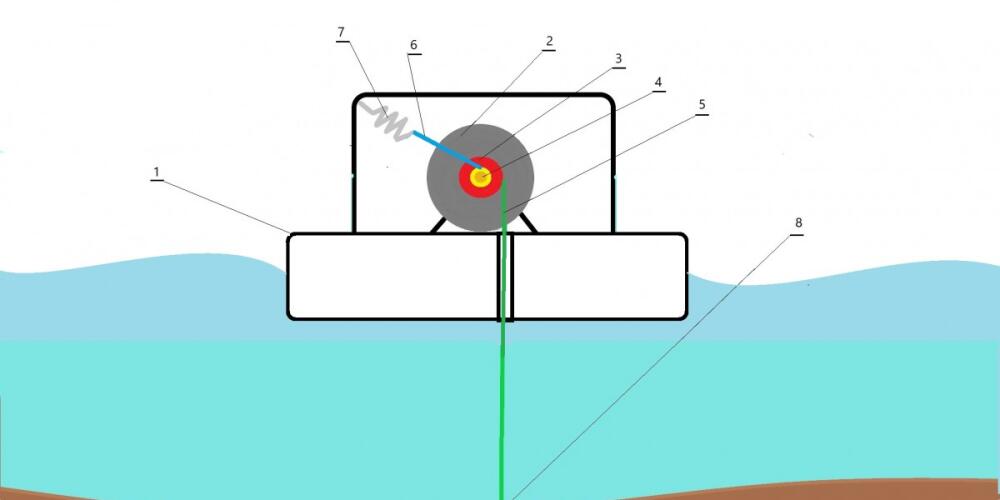
There are several ways to generate energy from waves. Most of these devices float on the surface of the water at sea, lakes, or rivers, and energy is generated by moving up and down. Inside most of these devices there are chambers inside which the water moves up and down, and thus the water pushes the air in the pipe like a piston. That air at the other end drives air turbines that drive electrical generators.
In recent times, materials have been developed that float on the surface of the water and generate electrical voltage when they bend.
Electricity can be created with a much simpler device than with existing solutions. The solution is shown in the picture above.
In the electric float (1) that generates electricity, it is possible to put a slow-moving, multipole electric generator (2) that generates electric voltage at a low number of revolutions of the rotor, regardless of the direction of rotation of the rotor.
There are two pulleys on the rotor shaft of the electric generator (2). An anchor rope (5) is wound on the larger pulley (3) and its other end is connected to an anchor (8) at the bottom of the sea, river, or lake. A tension rope (6) is wound on the smaller pulley (4) in the opposite direction. The other end of the tension rope (6) is connected to the spring (7).
When this type of electric float (1) floats on the surface of the water, waves rise up and down. When moving upwards, the anchor rope (5) is unwound from the larger pulley (3), whereby the larger pulley (3) turns, which also turns the rotor of the electric generator (2), and creates an electric voltage. When the water wave goes down, then the electric float (1) also moves down. At the same time, the spring (7) tightens the tension rope (6), which turns the smaller pulley (4), together with the rotor of the electric generator (2), which also creates electricity. Together with the smaller pulley (4), the larger pulley (3) rotates, on which the anchor rope (5) is wound. When the water wave goes up again, the process is repeated.
In this way, the rotor of the electric generator (2) constantly turns to one side, then to the other side, generating electricity. This electricity can be taken by cables to the land to the consumers. A larger number of such electric floats placed along the coasts of the sea could produce significant amounts of electricity. On small islands, it could be the most important source of electricity.
In the case of small floats that serve as waterway markers, the floats indicate shoals or rocks. There, such an energy-producing device could power searchlights at night, or sirens in fog that would warn ships of danger.
This kind of electric float(1) could also be installed on fishing boats, sailboats, yachts and other vessels. The electric float (1) would be placed in the place where the ship's anchor is located, and that anchor would be connected to the anchor rope (5). In this case, the electric generator(2) could work in two operating modes. In the first mode of operation, the electric generator (2) would produce electricity from the waves, while the ship is at anchor. In the second operating mode, the electric generator (2) would work as a motor for raising the anchor from the sea and lowering the anchor into the sea. The energy produced would charge the electric batteries, from which the energy could be used to start the electrical devices on the ship, and even to start the ship itself until the accumulated energy from the batteries is used up.
Some of my other innovations and technology analysis can be found here.
And the newer ones can be seen here.
Tags
Featured articles